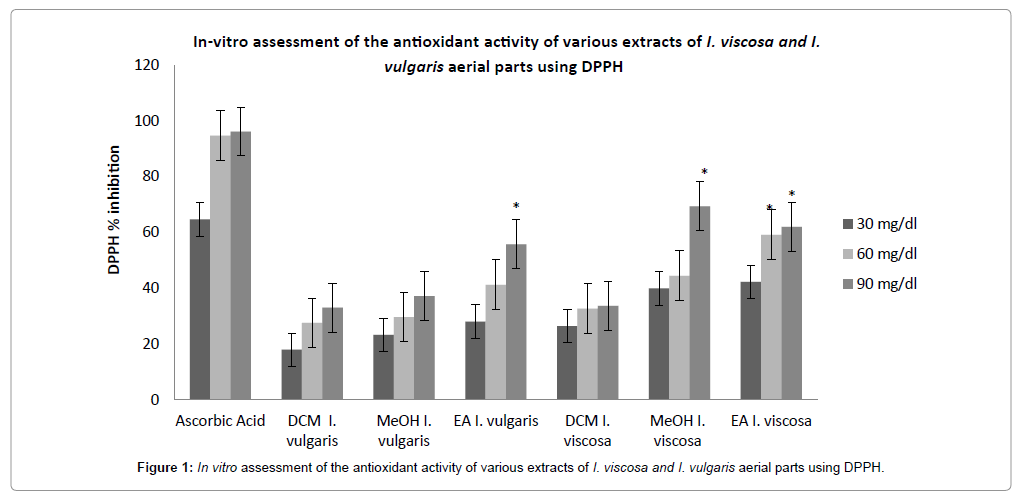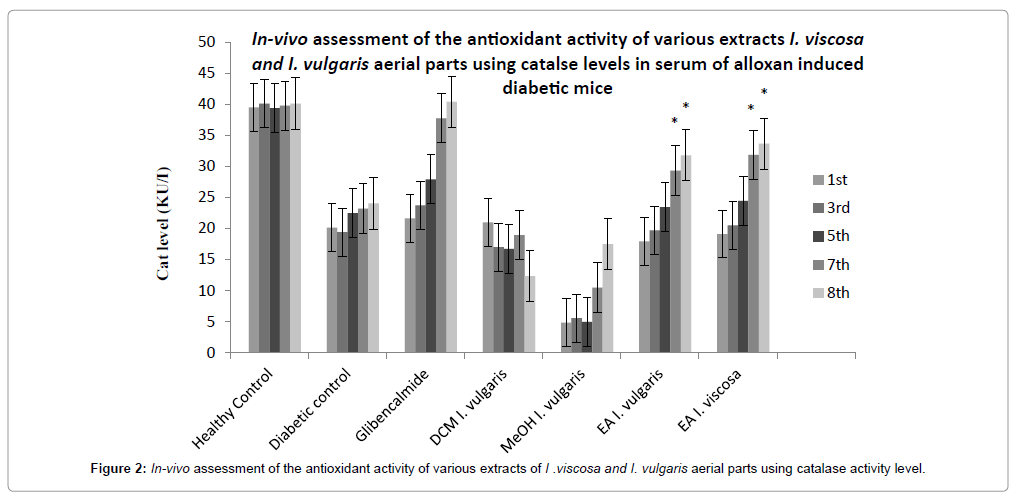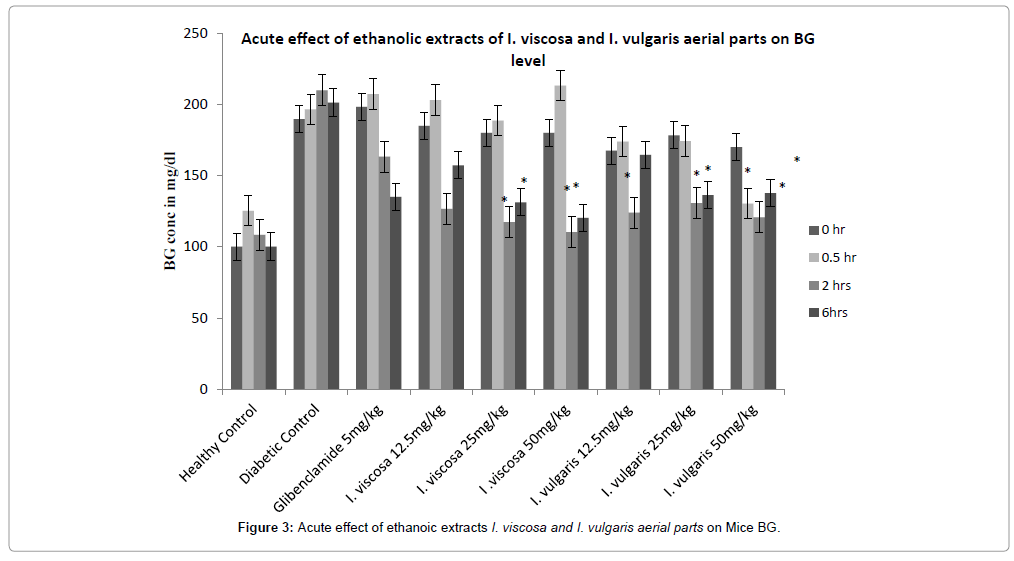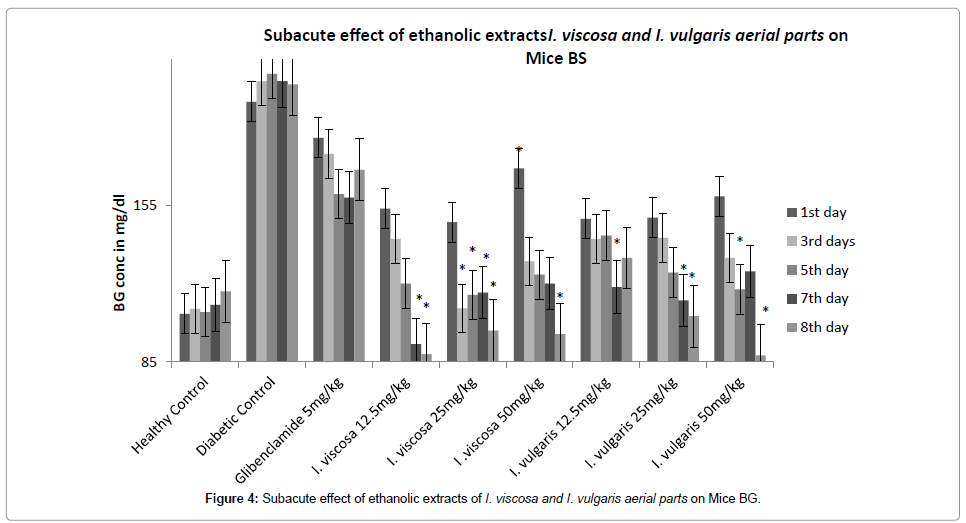Medicinal & Aromatic Plants
Open Access
ISSN: 2167-0412
+44 1300 500008
ISSN: 2167-0412
+44 1300 500008
Special Issue Article - (2015)
Inula species grown in Lebanon are known to have beneficial effects in improving human health. Several Inula species are used in traditional medicine as expectorants, antitussives, diaphoretics, antiemetics, and bactericides. In this study, different extracts of two Lebanese Inula species [Asteraceae], Inula viscosa [I. viscosa] and Inula vulgaris [I. vulgaris] aerial parts, were investigated for their in vivo and in vitro antioxidant and antidiabetic potential. Since increased oxidative stress has been linked to a shortening of life span, the antioxidant effect was studied due to the increased rate of oxidative damage during diabetes. Antioxidant activities of various extracts of the plant parts were measured using in vitro quenching of diphenyl-2-picrylhydrazyl free radical [DPPH radical scavenging assay] and in vivo assessment of catalase level in serum of alloxan-induced diabetic mice [6 groups, 3 mice/group]. The effect of various Inula spp. under investigation was studied for their acute [6 h] and subacute [8 days] potential on blood sugar level in alloxan-induced diabetic mice. I. viscosa and I. vulgaris have shown very promising antidiabetic and antioxidant effects, especially in vivo. Different extracts have demonstrated some variations in their antioxidant activities, due to difference in their total phenolic contents. It is highly important to consider Inula species in management of chronic diseases like, diabetes.
Inula viscosa; Inula vulgaris; DPPH; Phenolics; Antioxidant; Antidiabetic
Diabetes is a major degenerative disease in the world today, that is characterized by hyperglycemia, lipoprotein abnormalities, raised basal metabolic rate, defect in reactive oxygen species scavenging enzymes, and altered intermediary metabolism of major food substances [1]. Type 2 diabetes mellitus is a worldwide public health problem with serious morbidity, mortality and economic burdens. Global estimates for 2013 suggest that the number of people with type2 diabetes is 382 million, and this number is projected to increase to 592 million by 2030. There were 494,300 cases of diabetes in Lebanon in 2014 [2,3]. Traditional medicines and extracts from medicinal plants have been extensively used as alternative medicine for better control and management of diabetes mellitus [4]. Inula is a large genus in the Asteraceae family, native to Europe, Asia, and Africa. It has been reported that this includes about 200 species [5]. In Lebanon, it is represented by 7 species I. helenium, I. crithmoides, I. viscosa, I. graveolens, I. salicina, I. vulgaris, and I. heterolepis, although the last one of these species has vanished [6]. I. viscosa has been used for years in traditional folk medicine for its antioxidant, anti-inflammatory [7], antipyretic, antiseptic [8], and antidiabetic properties [9]. Diverse biological activities have been attributed to this genus. Evidence for the antifungal, antibacterial, antitumor, and anti-inflammatory, activity in plant extracts was reported [10]. This herb I. viscosa has anti-ulcerogenic effects, has also been used for treating gastro-duodenal disorders [11]. Chemical analysis showed that I. viscosa contains many biologically active compounds, including flavonoids, phenolic compounds and Terpenoids [12]. Taking into account the wide distribution and traditional use of I. viscosa, and the lack of studies that evaluate the biological activity of the pure compounds of I. vulgaris, the present study was undertaken to evaluate the antidiabetic and antioxidant effect of the extracts of the two species. This work represents a comparative pharmacological investigation of these two Inula species growing in Lebanon. A large number of the Asteraceae plants were studied in many parts of the world, because they are rich in sesquiterpene lactones and other secondary metabolites [4]. This study aims to investigate the in vivo and the in vitro antioxidant and antidiabetic potential of various Lebanese Inula species.
Plant material
Dried aerial parts of I. viscosa and I. vulgaris species [Asteraceae] were collected in July 2012 from Rawche and Gharifa respectively during flowering stages. They were identified by Prof. G. Tohme [Lebanese University, Lebanon]. Dried specimens were deposited in the Faculty herbarium [specimen no. 2015-P030 I. viscosa and 2015- P031 I. vulgaris].
Preparation of plant extracts
Dried plant materials were separately dried and size-reduced using TCM grinder [TCM, China]. All plant materials were extracted using 4 L of 80% ethanol and were stirred for two weeks in their ethanolic liquors and then dried. The plant extracts were purified through petroleum ether, then the dichloromethane [DCM] and ethyl acetate [EA] fractions were isolated using separatory funnel. The extracts were double filtered and well dried using Rotavap [Buchi, Germany] at temperature 40°C under vacuum [13].
Animals
Eighteen to twenty four weeks old male Swiss-Webster mice weighing from 25-35 g were obtained from Faculty of Pharmacy, Beirut Arab University [BAU]. All animals were housed for 1 week at certain conditions prior to starting the experiments. The standard mice cages were subjected to a 12 h Light/ dark cycle. The temperature was 22 ± 1°C, animals had free access to water and standard laboratory pellets [20% proteins, 5% fats, and 1% multivitamins] [10]. Sixteen hours before the experiments, they were fasted overnight, but permitted open access to water. All animal care and experiments were performed in accordance with animal experiment legislation and with approval of the Institutional Review Board [IRB] at BAU [14].
Diabetes induction
Freshly prepared alloxan [Sigma-Aldrich, Germany] dissolved in sterile cold saline [vehicle] was i.p. injected every 48 h for three times at a dose of 180 mg/kg to induce diabetes. The blood samples were obtained from the tail of each mouse 72 h after the last alloxan injection. Glucose strips test meter [Accuchek Performa™, Roche, USA] was used to measure the glucose levels [14].
Acute effect of plant extracts in alloxan-induced diabetic mice
Three Mice of group I were healthy and received only i.p vehicle for 7 days and served as control. The diabetic mice were divided into 5 groups [3 mice/group]. Group II received only i.p. injections of vehicle and served as control. Group III received i.p. glibenclamide [GB] as reference drug [5 mg/kg] dissolved in DMSO. Groups IV, V, and VI received the plant ethanolic extracts dissolved in vehicle at the doses of 12.5, 25 and 50 mg/kg i.p., respectively. Blood glucose and body weight were determined after the blood samples collection from the tail just prior to and at 0.5, 2 and 6 h after dosing.
Sub-acute effect of the plant extracts in alloxan-induced diabetic mice
In order to determine the sub-acute effect of various extracts, activity was tested during a longer duration of treatment. The mice were divided into groups containing healthy and diabetic animals. Mice of group I was healthy and received only i.p vehicle only for 7 days and served as control. The diabetic mice were divided into five groups [II-VI] of three animals each. Group II mice served as diabetic control and received only i.p vehicle for 7 days. Group III received i.p. GB [5 mg/kg] dissolved in DMSO for 7 days [positive control]. The remaining groups IV, V and VI received i.p the plant ethanolic extracts, dissolved in vehicle, at the doses of 12.5, 25 and 50 mg/kg respectively. After the blood samples collection from the tail at 1st, 3rd, 5th, and 8th days after each treatment, the blood glucose and body weight were determined.
Assessment of in vitro antioxidant activity [DPPH free radical scavenging activity]
Based on scavenging ability of stable 1,1-diphenyl-2-picrylhydrazyl [DPPH] radicals, the method modified by Brand-Williams [1995] was employed. A volume of 50 ᴫl of various Inula extracts concentrations in methanol was added to 5 ml of 0.004% Methanol solution of DPPH. The reaction mixture was incubated for 30 min at room temperature. Absorbance of the resultant mixture was recorded at 517 nm using UV-VIS spectrophotometer, [Jasco, Japan]. The percentage of DPPH scavenging by the extracts and standard compounds were calculated as follows: %Inhibition=[[A−A1]/A0] × 100, where A0 is the absorbance of the control containing all reagents except the test compound, and A1 is the absorbance in the presence of the sample, i.e the test compound. The graph of % inhibition versus concentration was plotted to get IC50 [15] (Figure 1).

Figure 1: In vitro assessment of the antioxidant activity of various extracts of I. viscosa and I. vulgaris aerial parts using DPPH.
Assessment of in vivo antioxidant activity
Serum Catalase [CAT] activity was determined using the method modified from Aebi, as described in literature [11]. The reaction is carried out in 1st order kinetics to avoid inactivation of CAT by H2O2. The reaction mixture at 30°C contains 5 μl serum and 395 μl of phosphate buffer, [pH 7.0] in a quartz cuvette [1 cm light path]. At zero time, the reaction is started by the addition of 200 μl of 38 mmol/l of H2O2 in phosphate buffer, and the absorbance at 240 nm is monitored for 5 min. Serum CAT activity was calculated as ΔA/min × [800/5] × 1/0.04 and expressed as kU/l. ΔA/min is the initial rate of reaction calculated form linear portion of the curve, 800/5 is the dilution factor of serum, and 0.04 is the millimolar absorbitivity of H2O2 (Figure 2).

Figure 2: In-vivo assessment of the antioxidant activity of various extracts of I .viscosa and I. vulgaris aerial parts using catalase activity level.
Statistical analysis
All values were presented as means ± S.E.M. Statistical analyses were conducted by using the “SSPS” program. A difference in the mean values of p<0.05 or less was regarded to be statistically significant.
In comparison to the diabetic control, all the two plants samples reduced the blood glucose concentration in different extents. It was found that the samples with higher doses have remarkable effects on the blood glucose level, where 50 mg/kg I. viscosa reduced the BG levels from 180.00 to 120.33 mg/dl, and 50 mg/kg I. vulgaris reduced the BG levels from 170.00 to 137.66 mg/dl. This shows that both plants have very remarkable acute effects on the BG levels in alloxan induced diabetic mice. All other concentrations show also efficient results, however the level reduction by I. viscosa is greater as can be compared in Figure 3. For the subacute effects of the same doses of both extracts, Figure 2 shows that 50 mg/kg of both extracts showed remarkable diminishing of blood glucose level in the last two days. But again, the doses of I. viscosa showed greater effects in comparison to I. vulgaris as can be determined from the different doses of each extract after the 5th, 7th and 8th day. Higher doses of each, [50 mg/kg] were of greater effect and exaggerated reduction of blood sugar after the 8th day [From 171.50 mg/dl to 97.50 mg/dl for I. viscosa and from 159.00 mg/ dl to 88.00 mg/dl for I. vulgaris]. Figure 4 demonstrates the different effects of each extracts with respect to doses and days of treatment. After the ethanolic extracts were investigated for their antidiabetic effect, the DCM and EA fractions of the ethanolic extract were taken to study the antioxidant effect. Concerning the in vitro assessment of the antioxidant activity of various extracts of I. viscosa and I. vulgaris aerial parts using DPPH with st. L-ascorbic acid as reference, the ethyl acetate extracts were found to have the greater antioxidant effects. In comparison to 90 mg/kg administered st. ascorbic acid [94.67 ± 0.56], the 50 inhibitory concentration [IC50] was 41.23 ± 0.00 for the I. vulgaris to 59.16 ± 0.96 of I. viscosa. The greater the IC50 the greater the DPPH scavenging activity is shown. It is very clear that the effect of EA extracts was the most efficient in comparison to other extracts from one side and to the controls from second side. Also it is very clear that the DPPH scavenging activity of I. viscosa was greater. In order to evaluate in vivo antioxidant effect of the various extracts, CAT level in serum of each mouse was monitored on 1st, 3rd, 5th, 7th and 8th days. Diabetic mice treated with 25 mg/kg of each extract had a gradual rise in serum CAT activity to reach a significant difference on 5th, 7th and 8th day as compared with diabetic control mice. Again I. viscosa showed slight greater level of Cat enzyme [33.65 ± 0.35 versus 31.80 ± 0.20 KU/l], which indicates slight greater antioxidant effect. While hyperglycemia induces free radicals; and impairs the endogenous antioxidant defense system, endogenous antioxidant defense mechanisms including enzymatic pathways such as Cat act on decreasing oxidative stress. Long-term treatment of DM with the two plants extracts had reversed the free radicals activities, which might be due to lessened oxidative stress as evidenced by the elevation in CAT activity. Such lessening is greatly more when EA fractions are used.

Figure 3: Acute effect of ethanoic extracts I. viscosa and I. vulgaris aerial parts on Mice BG.

Figure 4: Subacute effect of ethanolic extracts of I. viscosa and I. vulgaris aerial parts on Mice BG.
Free radical scavenging activity of ethyl acetate extracts was confirmed in the present investigation. Thus it is clear that Inula species are rich in polyphenolic compounds. Such compounds play an important role as bioactive principles. However, polyphenolic constituents present in these extracts, which are responsible for this activity, need to be investigated in the Lebanese I. viscosa being a vital source of many previously isolated and identified phenolic compounds in many regions in the world, and in the Lebanese I. vulgaris species, being the first study done on the latter species. The study showed affordable results that could be followed by other studies to isolate phenolic compounds and others with noticeable effects.
Citation: Assi M, Ela MA, Raafat K, El-Lakany A (2015) Role of Antioxidants in the Antidiabetic Potential of Two Indigenous Lebanese Inula Species. Med Aromat Plants S2:002. doi: 10.4172/2167-0412.S2-002.
Received: 26-May-2015 Accepted: 22-Jun-2015 Published: 26-Jun-2015
Copyright: © 2015 Assi M, et al. This is an open-access article distributed under the terms of the Creative Commons Attribution License, which permits unrestricted use, distribution, and reproduction in any medium, provided the original author and source are credited.